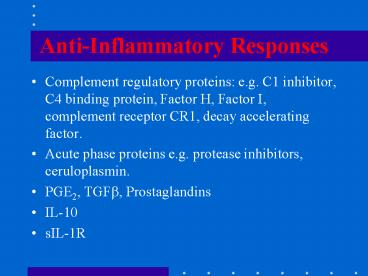Anti-Inflammatory Responses - PowerPoint PPT Presentation
1 / 26
Title:
Anti-Inflammatory Responses
Description:
Anti-Inflammatory Responses Complement regulatory proteins: e.g. C1 inhibitor, C4 binding protein, Factor H, Factor I, complement receptor CR1, decay accelerating factor. – PowerPoint PPT presentation
Number of Views:65
Avg rating:3.0/5.0
Title: Anti-Inflammatory Responses
1
Anti-Inflammatory Responses
- Complement regulatory proteins e.g. C1
inhibitor, C4 binding protein, Factor H, Factor
I, complement receptor CR1, decay accelerating
factor. - Acute phase proteins e.g. protease inhibitors,
ceruloplasmin. - PGE2, TGF?, Prostaglandins
- IL-10
- sIL-1R
2
Immunopathology
- Virus-bacterium synergistic pathology
- Sepsis and Endotoxemia
- Molecular mimicry
- Superantigens
3
Virus-Bacterium Synergy
- Enhancement of inflammatory response by bacterial
growth, IFN?, complement. - Increased tissue damage by bacterial toxins
(cytolysin, LPS) - Amplification of macrophage reactivity by
cytokines, LPS,
4
Sepsis and Endotoxemia
- Proinflammatory cytokinesTNF?, IFN?, IL-1,
IL-6, IL-8, IFN?, IFN? - C5a
- Neutropenia
- Soluble cytokine receptors (TNF-R, IL-1R)
5
Molecular Mimicry
- Chlamydia - heart
- Campylobacter - Guillan-Barre syndrome
6
Superantigens
- S. aureus enterotoxins causing food poisoning,
vomiting diarrhea (SEA, SEB). - ? Lymphocyte proliferation
- ? Cytokine production
- Toxic shock syndrome.
7
Immune Evasion
- Camouflage
- Encapsulation
- Antigenic mimicry
- Antigenic masking
- Antigenic shift
- Latency
- Intracellular replication
- Subversion
- Production of anti-Ig proteases
- Destruction of phagocyte
- Inhibition of chemotaxis
- Inhibition of phagocytosis
- Inhibition of phagolysosome fusion
- Resistance to lysosomal enzymes
- Superantigens
8
Mechanisms of Immune Evasion I Camouflage
- Capsule formation
- S aureus protein A
- Sialic acid
- LPS O protein
- S aureus coagulase
- M bacterium granuloma formation
9
Mechanisms of Immune Evasion III
Anti-Phagocytosis
- Inhibit opsonization (S aureus protein A)
- Inhibit chemotaxis
- Kill phagocyte (S aureus streptolysin)
- Inhibit phagocytosis (S pneumoniae capsule, S
pyogenes M protein) - Inhibit lysosomal fusion (M. tuberculosis)
- Escape lysosome and grow in cytoplasm
(Mycobacteria, Salmonella, S. aureus) - Block activation by IFN? (Mycobacteria)
- Viral envelope glycoproteins
- LPS
10
Mechanisms of Immune Evasion II Proteases
- Inhibit opsonization (N gonorrhoeae IgA protease)
- Inhibit chemotaxis
- Kill phagocyte (S aureus streptolysin)
- Inhibit phagocytosis (S pneumoniae capsule, S
pyogenes M protein) - Inhibit lysosomal fusion (M. tuberculosis)
- Escape lysosome and grow in cytoplasm
(Mycobacteria, Salmonella, S. aureus) - Block activation by IFN? (Mycobacteria)
- Viral envelope glycoproteins
- LPS
11
Viral Mechanisms of Immune Evasion I
- Humoral Response
- Latency e.g. HSV, retroviruses
- Syncytia formation e.g. HSV, VZV, HIV
- Antigenic variation e.g. HIV
- Blocking antigen e.g. HBV e Ag
- Complement decay e.g. HSV
12
Viral Mechanisms of Immune Evasion II.
- Interferon
- HBV blocks transcription of IFN?
- EBV synthesizes BRC1, an analogue of IL-10.
- Adenovirus RNA - double stranded duplex blocks
interferon antiviral action early protein binds
cl I heavy chain preventing upregulated expression
13
Viral Mechanisms of Immune Evasion III
- Immune Cell Function
- CTL cytolysis e.g. HSV
- TH depletion e.g. HIV
- Immunosuppression e.g. measles, EBV
14
Viral Mechanisms of Immune Evasion IV.
- Antigen Presentation
- Inhibition of Cl I MHC expression e.g.
Adenovirus, CMV - Inactivating peptides e.g. HBV
- Inhibition of Inflammation
- Blocking of inflammatory cytokines e.g.
Poxviruses, adenovirus.
15
Infection and Pathogenesis
- Colonization (Benign or asymptomatic) ?Infectio
n ? ? Disease (Pathogenesis) ? Clinical or
Subclinical
16
Requisites for Successful Growth
- Attachment
- Nutrition
- Survival from host defence
- Transmission
17
Virulence Factors
- Factors which promote infection and which
contribute to disease - Studied with mutants
- Are multifactorial
- Consist of
- Factors promoting colonization and invasion
- Factors which are pathogenic
18
Bacterial Virulence Factors I Colonization
- Adherence Capsules, Pili, adhesins
- Penetration e.g. invasins
- Host gene modification.
19
Capsules
- Present in some gram negative and positive
bacteria. - May be composed of protein or polysaccharide
layers. - Is poorly antigenic and anti-phagocytic
- Can act as a barrier to toxic hydrophobic
molecules such as detergents. - Can promote adherence to other bacteria or cell
surfaces
20
Pili (Fimbriae)
- Composed of subunits of pilin.
- Promote adherence to other bacteria or host.
- Synonyms adhesins, lectins, evasins, aggressins.
- Fragile, often replaced.
21
Bacterial Pathogenesis
- Toxic byproducts of bacterial growthe.g. acids,
gas, proteases - Toxins
- Endotoxins e.g. LPS
- Exotoxins
- Immunopathogenesis e.g. Chlamydia, treponemes
(syphilis), Borrelia (Lyme disease)
22
Endotoxins Lipopolysaccharide
- Fever
- Leukopenia, followed by leukocytosis
- Complement activation
- Thrombocytopenia
- Coagulation
- Decreased blood circulation
- Shock
- Death
23
Exotoxins
- AB. e.g. Shigella dysenteriae, C. tetani, V.
cholerae. - Cell Membrane Disruption. e.g. C. perfringens
- Superantigens. e.g. S. aureus
24
Exotoxins I AB (i)
25
Exotoxins IAB (ii)
26
Exotoxins I AB (iii)































